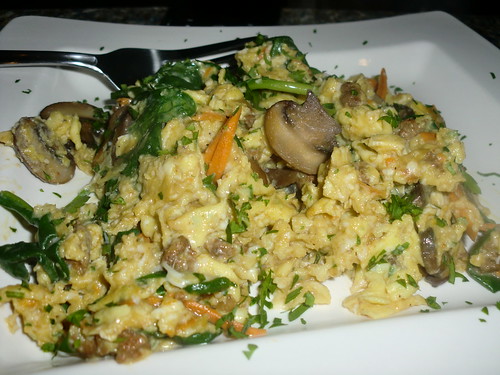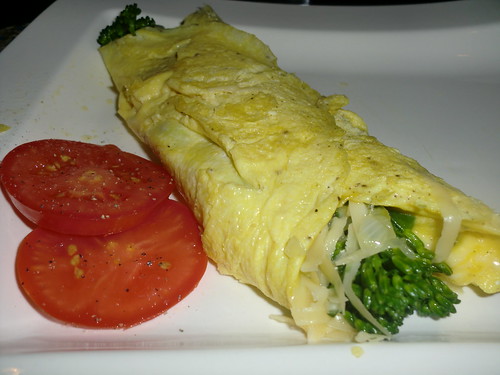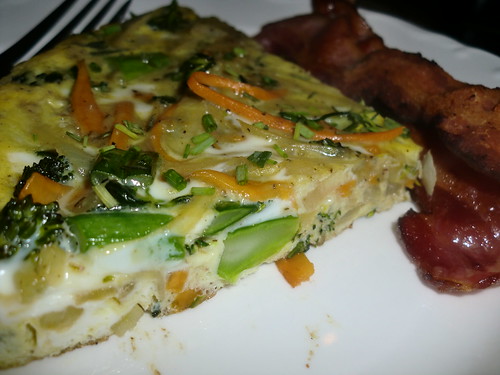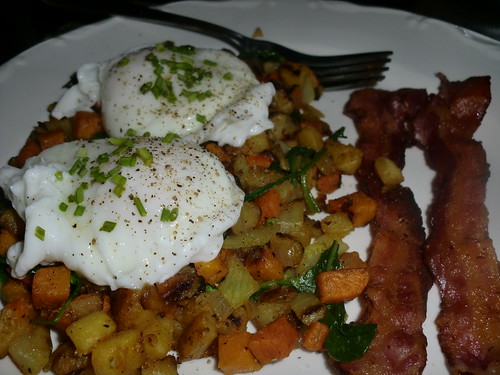I decided to put together a list of tips that will make any home cook like me a little better. I watched WAY too much Food Network over the last year, and I have learned many-a-tip and trick that make meals so much easier and tastier. This is school of hard knocks stuff. Confidence is seriously the difference between the people that say “I can’t cook” and the ones that cook awesome stuff. Hopefully these tips will make you a little bit more confident at dinnertime.
Number 1: Cook (almost) everything on a HOT surface.
I know…not exactly something you’ve never heard, but when I say HOT, I mean HOT, not warm. This means, heat your pan or grill so that the food makes sizzle noises when you drop it in. Cooking with hot metal makes good, crusty, brown food…nobody likes a gray steak or soggy, wet vegetables. There are exceptions (chopped garlic burns fast, eggs are better with low heat, and bacon will get crispier if start with a cool pan) but generally speaking, go hot metal.
Number 2: Learn some knife skills.
Important early lessons include dicing onions, julienning (is that a word?) and dicing carrots, squash, zucchini, potatoes, and other similar vegetables. There are hundreds of how-to’s on Youtube for proper knife technique. When things are cut the same size, they cook evenly. Do some Googling and practice often. Speaking of cutting practice…
Number 3: Approach each meal/recipe with some organization.
Plan ahead as often as possible with prep. I use onions in almost every meal, so if I happen to be cooking dinner, I will dice one extra onion and bag it up for later. Dice up vegetables, defrost meat, make salad dressings, and get meals in the Crockpot early and cooking is much easier.
Number 4: Clean as you go.
No one likes a sink full of dirty crap after eating a nice meal. While things are cooking, clean up. If you are constantly cleaning and cooking, you lose no time, and leave no mess, but keep a sharp eye on your pan so nothing burns.
Number 5: Cook more than you will need.
Might be the most useful tip of all. Huge dinner on Tuesday night = Wednesday breakfast and lunch.
Number 6: Season everything…salt is your friend.
If you stay away from processed food, no need to fret about the sodium. As you cook, add good salt…probably more than you think you should, and everything will taste better.
Number 7: Buy a nice digital meat thermometer.
It is very hard to ‘eyeball’ medium rare steak or medium pork chops. If you can do that consistently, congrats, you are better than my blog and me. For everyone else, use a thermometer stuck into the thickest part (or area near a bone) of the meat and use this chart.
Number 8: Keep some fresh herbs around.
Add them to pretty much every meal, chopped up. Chopped parsley looks good on the plate, too.
Number 9: Learn how to make some vinaigrette's.
Pretty easy stuff. First, buy some good vinegars (balsamic, red wine, champagne, apple cider are my go-tos) and some good extra virgin olive oil. Most basic version is about 1 part vinegar and some salt and pepper to 2-3 parts olive oil. Whisk them together by slowly drizzling in the oil. Play around with this recipe by adding Dijon mustard, herbs, chopped garlic, shallots, or any other spices (you can also replace the vinegar with citrus juices). Good vinaigrette's make great salad dressings, sauces, and marinades.
Number 10: Wing it often.
Don’t get caught up in the “Is it ½ teaspoon or ¾ teaspoon of paprika game?” I still do this too much. It really doesn’t matter…it will taste good if you are in the ballpark.
When going off-recipe, it helps me to think in terms of flavors. Try to balance one part of the meal with another. Pair salty pork with sweet apples. Stuff spicy jalapenos with creamy cheeses. You get the idea.
Now go cook something!












































